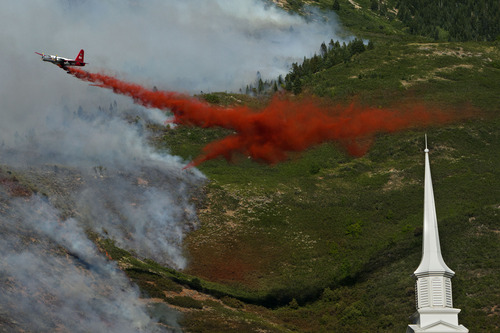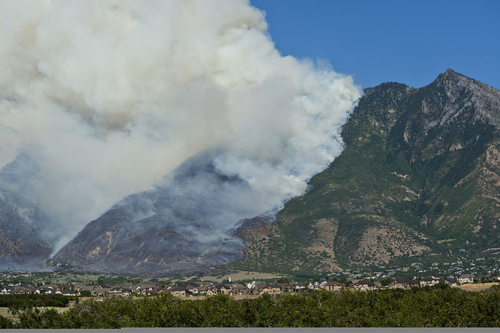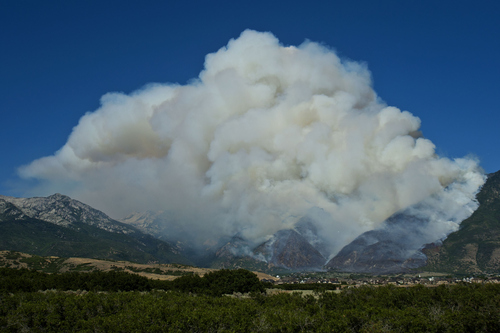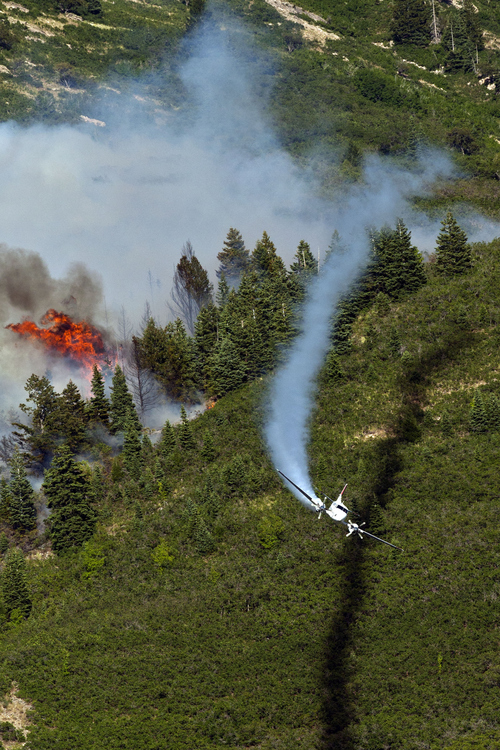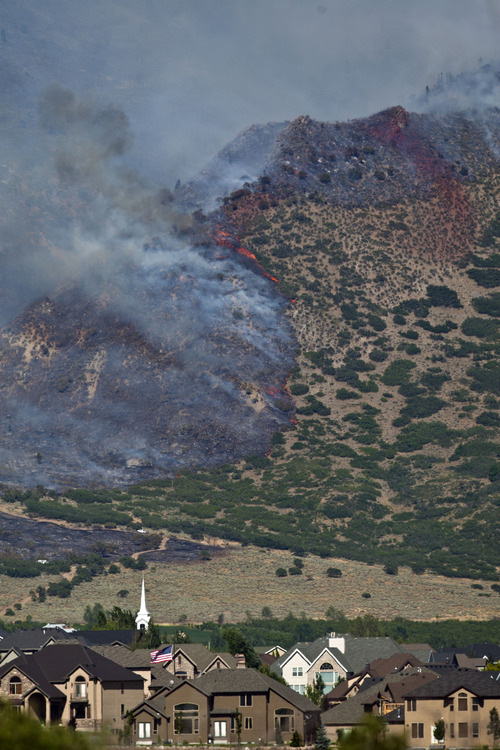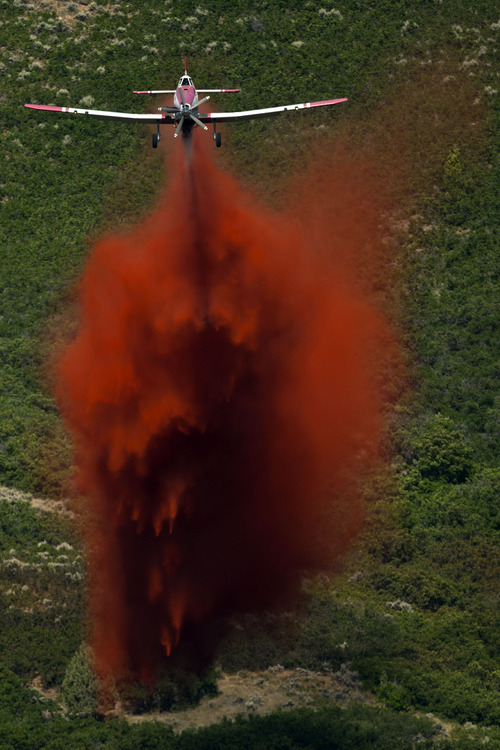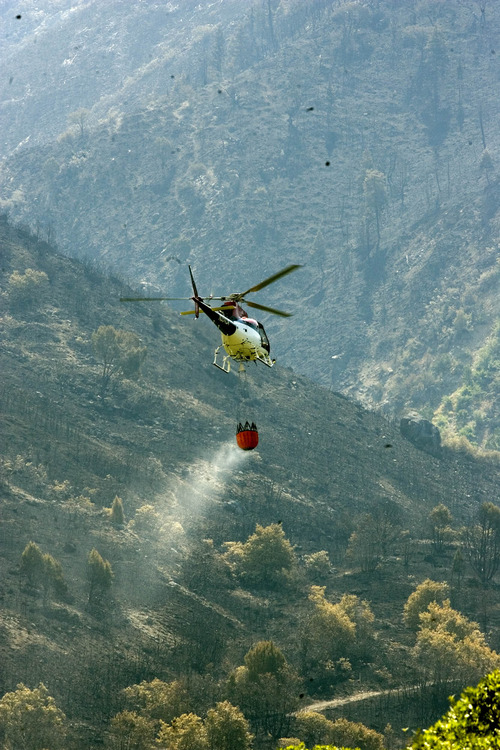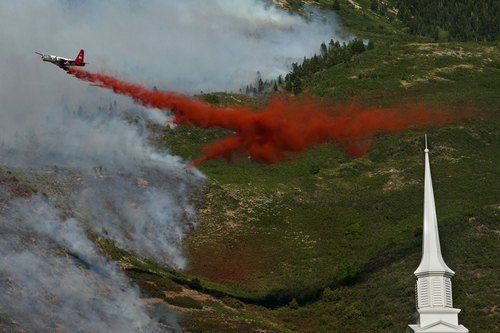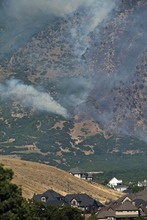This is an archived article that was published on sltrib.com in 2013, and information in the article may be outdated. It is provided only for personal research purposes and may not be reprinted.
While trenching in a future subdivision last summer where the town of Alpine meets a national forest, a track hoe operator discovered the brush behind him was on fire. He quickly pushed dirt on the flames, but within seconds an engineer, a geologist and their intern were running for their lives.
They climbed into their trucks and drove away through a wall of fire. They could feel the heat through their windshields and feared the track hoe operator was a goner, according to their boss Tim Thompson of GeoStrata, a geotechnical consultant based in Bluffdale.
"The fire spread faster than anyone could have imagined. My employees almost got killed," said Thompson, who was on the phone with one of his men the moment the fire started July 3. "It went up like a Roman candle. Two of our guys ran one way, one ran the other and they didn't know each other was safe till they met up down the road. It was one of those things that shook the whole company."
Documents released last week by the U.S. Forest Service explain in detail how the trenching triggered the Quail Fire that scorched 2,200 acres, spurred the evacuation of about 500 homes and incurred at least $1.3 million in suppression costs and many thousands more in rehabilitation.
The U.S. attorney's office in Salt Lake City reviewed the report and declined to file charges.
"We don't believe the conduct rose to the level of a criminal prosecution," said Melodie Rydalch, a spokeswoman for the U.S. attorney. "Non-arson fires are generally not handled through the criminal process, but that doesn't mean people aren't held responsible. We routinely pursue civil recovery for suppression costs. That process is just starting."
Alpine Mayor Hunt Willoughby hoped his town could recoup some its expenses, which weren't astronomical, but it was still money it wasn't planning to spend. No lives or homes were lost, thanks in part to the efforts of the fire's initial responders.
"We had some firemen who did heroic things. They made decisions that saved lives," Willoughby said. But the community's Lambert Park faces the possibility of mudslides until the hill above it re-vegetates so the town is investing in slope stabilization and monitoring equipment.
"I appreciate the federal government stepping in, doing the portion they're doing," Willoughby said. "The state has put in a weather station to measure rainfall in five-minute intervals."
But figuring out who should pay may prove complicated. GeoStrata was there to investigate geological hazards for Utah County homebuilder Patterson Construction, which was developing the East Bench Estates subdivision. The track hoe was operated by a subcontractor, Sunset Mountain Machinery.
James Patterson, president of Patterson Construction, did not return a phone message.
While investigators concluded the track hoe ignited the blaze, they were uncertain how. Metal fragments and scrape marks found at the point of origin suggested the blade struck rocks and could have caused fire-starting friction. The engine had been malfunctioning that day. Perhaps the engine emitted sparks or came into contact with cheat grass. Investigators listed all these things as possible triggers.
And July 3 was a remarkable afternoon, ripe for wildfire. Hot dry winds blew out of the south, pushing against the Wasatch foothills. Fires were burning all over the state, which was under a red flag warning.
Last year was one of Utah's busiest wildfire seasons, blackening more than 400,000 acres in 1,528 fires.
According to results of a Bureau of Land Management investigation released last week with names redacted, the trenching began at 10:30 a.m. on July 3. The temperature reached 93 degrees that afternoon, when winds kicked up to 18 mph with 28 mph gusts, and relative humidity sank to 6 percent.
A new track hoe operator arrived at 1:30 p.m., but he soon had trouble with the equipment stalling. The crew called back the first operator, who returned and sprayed starting fluid into the hoe's engine compartment. Documents suggest this man was a Patterson employee who was moonlighting for Sunset on the day of the fire.
The machine came back to life and the troubleshooter remained to refuel the hoe as it resumed work on the trench. But within a few minutes flames appeared under or behind the hoe.
"In a matter of seconds the fire spread about 20 feet, igniting everything that was down wind," a GeoStrata employee wrote in a statement to investigators. "I quickly realized that there was nothing that we could do to stop the fire and that we should immediately leave out of the path of the fire."
The three GeoStrata employees drove to safety and called 911, while the track hoe operator remained with the equipment, piling dirt in a successful effort to protect himself and the machine. But it did nothing to thwart the fire's northeast advance up Box Elder Peak in the Uinta-Wasatch-Cache National Forest. During the next few days, 93 acres of private land burned along with another 2,127 of national forest. A barn was lost and two homes damaged.
It remains debatable whether the trenching crew members exercised sound judgment, given the extreme conditions that day, but GeoStrata's Thompson contends they did nothing irresponsible.
"It was normal construction. It was something we do every day. There was nothing leaking off the track hoe. It wasn't overheating. They weren't neck-deep in brush," he said. He praised the operator, an employee of Sunset Mountain Machinery, who put himself at risk by remaining behind to smother the fire then protect the track hoe with gallons of diesel on board. Had the machine's fuel lines ruptured, fuel would have poured out and added to the fire, Thompson said.
But the operator left the scene without speaking to police, who were on hand interviewing the GeoStrata employees. Contacted later, he agreed to speak with investigators only with a lawyer present. He said the track hoe could not have started the fire and explained he avoids police because they always put him in jail, according to investigation documents. Yet the operator had sent a text message to his ex-wife saying he started the fire when he struck a rock with the track hoe.


